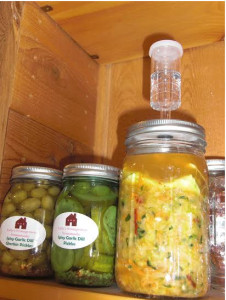Raw Sauerkraut with Chipotle and Cumin Seeds
- 09, 14, 2015
- Category Appetizers & Sides, Microbiome, Probiotic, Vegan, Vegetarian
- Posted By TheraCuisine
- Comments Off on Raw Sauerkraut with Chipotle and Cumin Seeds
Raw Sauerkraut with Chipotle and Cumin Seeds
Author: Chef Kelly Yorke
Serves: 1 Quart, 16 Portions
 Raw, unpasteurized, fermented and probiotic-rich sauerkraut is fresh and crisp and promotes a healthy microbiome. It tastes nothing like the pasteurized, mushy sauerkraut you see predominately in the grocery store. Sauerkraut is easy to make at home with as little as two ingredients - cabbage and salt. This recipe is made with a few more ingredients and produces a distinctively southwestern flair to the mixture. I like to use this sauerkraut as a probiotic-boosting ingredient in my Gazpacho soup recipe. It also tastes great on huevos rancheros, buffalo hotdogs, and on garden salads.
Raw, unpasteurized, fermented and probiotic-rich sauerkraut is fresh and crisp and promotes a healthy microbiome. It tastes nothing like the pasteurized, mushy sauerkraut you see predominately in the grocery store. Sauerkraut is easy to make at home with as little as two ingredients - cabbage and salt. This recipe is made with a few more ingredients and produces a distinctively southwestern flair to the mixture. I like to use this sauerkraut as a probiotic-boosting ingredient in my Gazpacho soup recipe. It also tastes great on huevos rancheros, buffalo hotdogs, and on garden salads.Ingredients
- 2 whole Chipotle peppers, smoked and dried
- 1 lbs. Cabbage, shredded (about ¾-1 small head cabbage)
- ½ cup Carrot, shredded
- ½ cup Leek, sliced across the bias into ⅛ inch-thick strips
- 1.5 tsp. Salt, picking or canning or other non-iodized salt without anti-caking agents
- 1 Tbls. Garlic, raw, minced Emperor’s Kitchen Organic Chopped Garlic 4.5 oz. jar
- 1.5 tsp. Dried cilantro leaves, or 1Tbls. Freshly chopped cilantro
- 1.5 tsp. Cumin seed
- 1 each Pickle-Pro water lock lid
- 1/16 tsp. Veggie Fermenting Starter Culture
- 1 each Quart sized, wide mouth Mason jar
Instructions
- Make sure your cutting board, hands, knife, bowls, tools and the quart sized Mason jar that you will be using to make this recipe are nice and clean so you ensure the good probiotics will thrive in this recipe instead of any bad pathogens.
- Place dried peppers in small bowl and pour enough boiling water over them to cover. Set bowl aside to let peppers soften and rehydrate (about 10 minutes).
- Cut the core out of the cabbage and discard it. Slice the remaining cabbage into thin strips or shred it using the grating blade attachment in a food processor. Place the cabbage in a very large bowl. Shred the carrots using a box grater or the food processor with a grating blade and place the carrots in the bowl with the cabbage. Slice the leek in half lengthwise and clean between the layers to remove any sand or grit then cut leek across the bias into ⅛" thick slices and add them to the bowl with the cabbage and carrots. Add the salt to the bowl with the vegetables and with clean hands toss the vegetables lightly to evenly distribute the salt with the vegetables. Allow the mixture to sit for about 10 minutes to allow the salt to start to draw the moisture out of the vegetables and begin to soften them.
- Meanwhile, peel, smash and mince the garlic cloves and set them aside. Trim off the stem from the chipotle and discard. Slice chipotle in half lengthwise and remove the seeds (or leave them intact for more intense heat level). Cut chipotle into julienne strips.
- Place two Tablespoons of filtered, room-temperature (non-chlorinated) water in a small bowl and dissolve 1/16 teaspoon of starter culture in the water. Let bowl sit for 20 minutes to activate the cultures.
- Meanwhile go back to the vegetable bowl and again with very clean hands start squishing the mixture between your hands to break down the plant wall fibers in the vegetables and squeeze out the liquid. The goal is to condense the volume down and create a liquidly brine that will accumulate in the bottom of the bowl. This is a process that will take about 5-7 minutes. At the end of that time toss in the garlic, cilantro, cumin seeds, chipotle and the activated culture water, continue to massage the mixture until the seasonings are evenly blended throughout the vegetables.
- Pack the vegetable mixture and cultured brine into a very clean quart size Mason jar (boiling sterilization is not necessary - but won’t hurt. However, good old soap and water will do just fine). Tamp down the vegetables with a very clean Prepper Pro tool from Homesteader’s Supply (link here?) or just fist as you go along to ensure the vegetables stay below the surface of the brine and to prevent air pockets. The fermentation process needs to take place in an anaerobic environment (no oxygen) so air pockets in the mixture or pieces of vegetable protruding above the surface of the liquid will allow mold to grow or air-exposed vegetables to rot, and should be avoided. Once the jar is packed to about 2 inches below the top, place a clean pickling jar weight (optional) on top of the vegetables so that they are pressed down below the surface of the brine and won’t float up. Seal the jar with a wide mouth Pickle Pro Lid and the metal outer rim of the wide mouth Mason or canning jar lid.
- Remove the top perforated cap of the water lock fitting; add filtered water up to the fill line. Replace the perforated cap on top of the water lock fitting.
- Place jar on a cookie sheet or other container that the jar can fit into that will catch any liquid overflow spillage that may occur. Set the jar in an area that the temperature is consistently between 60-75 F for 5-12 days and no less than 3-5 days.
- After the fermentation process has begun (within the first 24 - 48 hours) you will see bubbles and the contents in the jar will start heaving up due to the carbon dioxide that is produced during fermentation. This is normal and this is why you want to place a catch pan or dish under the jar if your ferment is particularly rigorous. After the first few days the rate of carbon dioxide heaving will settle down. After about the 5th day (assuming the jar was kept at a room temperature range of 72-75 F), various types of bacteria will have eaten enough food and produced enough lactic acid to lower the PH into an acidic level. The lactic acid brine that they create preserves the sauerkraut and prevents the growth of bad bacteria or pathogens.
- At any time after the first few days you can taste the contents daily to decide if you like the stage of flavor it has reached and when you do, you can slow down the fermentation process by placing the jar in the refrigerator. Do not however, taste the fermenting sauerkraut if (in the unlikely case) it has formed green, black, yellow or gray mold, smells putridly rotten or has become slimy in texture. The sauerkraut should smell somewhat sour but should not have an offensively bad odor. The use of an air lock lid during fermentation will highly reduce the chance of mold contaminating your fermenting sauerkraut.
- Using a starter culture speeds up the fermentation process more than if you were to ferment without one. Therefore, at some point after the heaving process has settled down and sometime between about the 5 and 12 day and when the level of sour-tanginess and flavor has reached a point that you like, remove the water lock lid and replace it with a regular canning jar lid. Transfer the sauerkraut jar to the refrigerator (temperature of 38°F - 44° F) or place it in a place that stays consistently cool (below 60° F) such as a root cellar to effectively slow down the fermentation process.
- The sauerkraut will keep in the refrigerator or cellar while it slowly continues to ferment for months. But, make sure you always use a clean utensil when scooping out any servings of sauerkraut from the jar in the meantime. Raw sauerkraut will still ferment under refrigeration but at a very slow rate until all the sugars are eaten by the probiotic bacteria or the PH level falls below 3 which is a PH level that is too acidic for them to survive. At that point the probiotics will die and fermentation will stop but the sauerkraut is still good to eat and is very easy to digest. And although the probiotic bacteria have died off, nutritious vitamins such as B, C and K, as well as the lactic acid (which aids in digestion) and beneficial enzymes will remain. Enjoy!
Notes
Per Serving: 15 Calories; trace Fat; 1g Protein; 3g Carbohydrate; 1g Dietary Fiber; 0mg Cholesterol; 208mg Sodium.
3.3.3077
Visit our Sponsors
Latest Recipes
- January is National Soup Month – Host a Soup Crawl
- Fiery, Sweet & Sour Cucumber Salad
- Celebrate In and Out of Season
- The Scoop on Honey
- Saffron – Expensive, but as Internationally Loved as The Olympics
Find Therapeutic Recipes
Osteoperosis Prostate Health Sidedish Recipes for Anti Inflammation from Chef Kelly Yorke IBS Vegan Easy to Follow Recipes for ADHD Organic, Healthy and Delicious Dessert Recipes Easy, Healthy Breakfast & Brunch Recipes PMS & Cramps Stroke Arthritis Pre-Diabetes Recipes to help the symptoms of Alzheimer's Disease Eye Health Healthy, Delicious Salad Recipes from Chef Kelly Yorke Depression Lunch Entrees that are Easy, Healthy and Delicious from Chef Kelly Yorke Diabetes Cold & Virus Recipes the improve Back Pain, from Chef Kelly Yorke Cancer fighting Probiotic Soup Gluten Free Menopause Appetizers & Sides Heart Healthy Headache Helping Insomnia Stress Vegetarian Memory Hypertension Breast Health Lactose Intolerant Microbiome Beverages Therapeutic Cuisine Dinner Recipes - Chef Kelly Yorke


